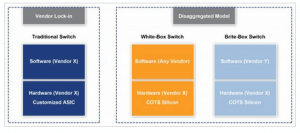White-box networking is gaining interest not just from hyper cloud networks but also from a host of other organizations whose business logic demand a dynamic, programmable and scalable network. Let’s examine some considerations behind adopting a white-box based architecture.

Bare-metal, white-box and brite-box switches:
Bare-metal switches decouple hardware from software and allow third-party software to be used on the switch instead of a tightly coupled, pre-loaded proprietary software platform the traditional vendor-based ASIC switch offering comes with.
Bare-metal hardware and white-box switches are essentially one and the same. Increased commoditization in networking, especially at scale, is giving organizations the ability to drive down costs by purchasing generic hardware. This hardware is typically based upon x86 processors and chipsets from silicon manufactures. These bare-metal switches may be purchased directly from the original equipment manufacturer (OEM), usually in large quantity for mass deployment.
A white-box switch can be considered a bare-metal switch with a software stack deployed over the top, either by an OEM or the end user. The Open Network Install Environment (ONIE) aims to bring standardization to bare-metal switching to ease the process of loading the software. ONIE provides a framework that allows the administrator to deploy different network operating systems (NOS) in the same way that x86 servers can be loaded with a variety of conventional operating systems.
The term “Brite-box” (aka “Brite-label”) switching, is shorthand for branded white-box switching (coined by a Gartner analyst).
Adoption of White-box:
There are primarily three types of organizations gravitating toward white-box switches:
- Web-scale companies that have the resources to deploy and maintain them
- Data center operators having more flexibility with greenfield deployments
- Companies that are cloud-based though not Web-scale
Although some of these concepts have been deployed by web-scale companies, it is becoming equally important for other enterprises to adopt similar architectures. The concept of NetOps driven culture is catching up in enterprises as well. While large cloud providers have the resources necessary to handle replacements and infrastructure maintenance on their own, it may take longer for bare-metal switching to become an option for enterprises. Vendor support tied to white-box offerings will help in this. That said, smaller companies can get better support and faster turnaround from white-box NOS vendors compared to large traditional networking vendors, which can be an added incentive to design networks that can meet their specific needs.
White-box switching provides several benefits versus traditional approaches; including massive capital cost reduction, reduced vendor lock-in, and increased software flexibility/programmability.However, there are barriers for mainstream and even service provider organizations to utilize white-box switching (like managing the acquisition process, integrating hardware/software, support, etc.). As a result, the first wave of white-box adoption has largely been limited to the hyper scale cloud providers.
Predictions:
Here are some projections for the adoption of this model. Crehan Research believes that, with the total cloud market expected to grow to about 12-million-plus ports by 2017, white-box deployment will increase about 32 percent a year to about 5 million data-center Ethernet white-box switch ports by 2017.
According to Gartner Research, even though Cisco still dominates the switch/router market with a 50 percent share, the white-box segment is growing quickly. Now at 3.8 percent of the market, Gartner estimates white-boxes will constitute about 10 percent of the 18 million switch ports installed by 2018.
In the next part, we will examine the tradeoffs for choosing the disaggregated model vs. the traditional vendor locked-in model.
Source: https://www.ipinfusion.com/the-path-to-white-box-networking-part-1/
Written by: Srikanth K., IP Infusion